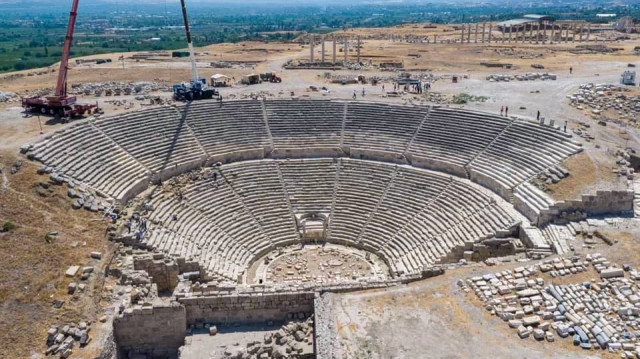
Once theater is fully restored, it will become significant venue for social events, says head of excavation works in western Türkiye
The restoration project for the 2,200-year-old theater in the ancient city of Assos in western Türkiye is nearing completion that will turn the site into one of the most important cultural destinations.
Located within the borders of Behramkale village in Ayvacik district of Türkiye’s Canakkale province, the significant ancient port city is known as a “center of learning.”
Situated on the slopes and summit of a volcanic hill overlooking the island of Lesbos, Assos was established at the southern tip of the region known in antiquity as "Troas" and served as a home to many civilizations over the centuries.
The famous philosopher, Aristotle, founded a school of philosophy here, where he conducted important research in zoology, biology, and botany. Excavations at the site, protected by city walls and supported by circular and square towers, have been ongoing since 1980.
The ancient city includes a theater, agora (public square), bouleuterion (council house), port, necropolis (cemetery), and gymnasium (athletic facility). The Temple of Athena, located within the site, is considered one of the oldest Doric-style temples in Anatolia, built during the Archaic Period.
Assos was the first ancient city excavated by American archaeologists in the 1800s. After a long hiatus, excavations resumed in 1981, and the 44th season of digs led by Turkish researchers is currently underway.
Speaking to Anadolu, head of the Assos excavations Prof. Nurettin Arslan said: "After receiving approval from the relevant authorities, restoration of the theater will likely begin this year."
"Following the restoration, the site may become one of the most important cultural destinations in Canakkale and across the country, hosting theatrical and concert performances during the summer months," Arslan noted.
"Among the ancient cities in Canakkale, Assos stands out as a well-preserved example. Once the theater is fully restored, it will become a significant venue for sustainable social events," he added.
- Assos Theater
The theater in the ancient city of Assos, built into a natural rock slope south of the agora, features a horseshoe-shaped layout typical of Greek theaters.
Constructed in the late 4th century BCE, it continued to be used during the Roman period with various modifications.
Due to gladiator and animal combats held during the Roman era, railings were added to the lower seating areas to protect spectators. Some seats were reserved for local trade guilds such as stonemasons, blacksmiths, and tanners. Additionally, one of the upper rows was designated for worshippers of Serapis, the Egyptian deity.
To the south of the orchestra stands a two-story stage building (proskenion). Only the half-columns in front of the proskenion were made of marble, while the rest of the structure was built from andesite stone.
Some missing parts of the theater were restored during conservation work carried out in the 1990s.







